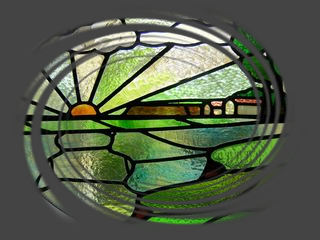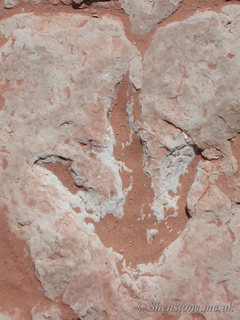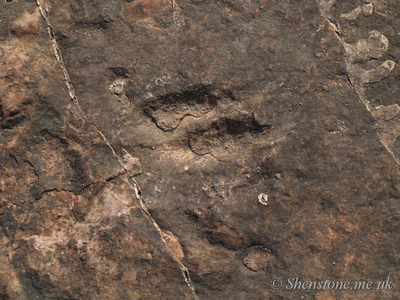 | Fossil Footprints Information... |

Three Toed Print Tuba City
Fossil footprints, the most enigmatic and yet informative of the types of fossils you can find.
How long does it take to make a footprint?
A second, maybe 2 or 5 if you are very slow moving.
How long does it take to dry out sufficiently to be preserved before the tide comes in or another flash flood covers it over and preserves it forever?
Hours, days or years?
However long it took to preserve, you still have that moment in time and there is so much information contained within that second or two or five that makes these some of the most useful fossils in understanding ancient environments
This series of pictures includes footprints from Bendrick Rocks & Sully, South Wales, Burniston Rocks, Yorkshire in the UK and Tuba City Arizona, Sauropod and possible pterosaur Tracks in Utah and Arizona, USA and Lark Quarry in Queensland, Australia.
The fossil footprints are formed when the creature has steped onto the soft sediment which has been covered up by another layer and the print preserved. The reason I just said "creature" is that whilst this page is called Dinosaur footprints the print shown in the picture at the top of this page has been claimed to be a Pterosaur which is not a Dinosaur it is a flying reptile. The print does however show very clearly the typical three toed print that is typical of many Dinosaurs.

Four Toed Print
The tracks in Bendrick Rocks are 220 million years old, Triassic in age, and therefore represent some of the earliest Dinosaur remains in the UK whilst those in Tuba City are later with a lower Jurassic age Burniston Rocks are from the Middle Jurassic when the age of the Dinosaurs was at it's height.
The Triassic rocks of South Wales are from a low desert area which was occasionally covered by flash floods. Smaller three toed prints were thought to be created by a dinosaur around the size and shape of Coelophysis. There are also some larger four toed prints such as this picture
As well as the individual prints this is also a good location to look at some tracks such as the one in the picture below which streches for about 2 meters and has at least 9 prints in it. Through careful analysis scientists can determine the speed, direction and other behavioural aspects of the creatures that made this track. What they cannot do unless a dead creature was to be found at the end of the track (and even then it would be speculation) is to determine exactly what type of dinosaur made these tracks. This does not stop scientists "having a good guess" based on all of the available evidence. One of the best things about science is the ability for different opinions to be shared and evidence debated until there is a strong set of evidence and agreement that a theory is correct, or as near to that as can be agreed. New evidence can always be found and then the theories have to change

Trackway, Sully
Burniston Rocks are a very different environment to that described in South Wales,. it is the remnants of old muddy river bed through and along which dinosaurs walked 160 million years ago. This was my original home area and I remember being taken down here to look for footprints as a child. it's nice to know that some 60 or so years later you can still do that.
The US sites were visted on a trip to Arizona and Utah. The variety of creatures includes small and large Dinosaurs and from Tuba even includes the marks we were told were left by Pterosaurs when they manoeuvered on the ground. Whatever they are, Navajos call the fossilized footprints "Naasho'illbahitsho Biikee'," which means "big lizard tracks." The sauropod tracks were in Utah and there was a sign saying that they were the first such tracks found in Utah. Sadly I did not take a good note of where they actually were (bad geologist!)
Most amazing is the mid-Cretaceous (late Albian-Cenomanian) Winton Formation, Lark quarry deposit from Australia where a mix of herbivore and carnivore tracks are said to intermingle It has been suggested that latter was chasing the former and gives evidence of a stampede of the smaller herbivorous dinosaurs as they were stalked by a large Theropod. However this may not be the case, it may be just a whole bunch of creatures wandering around a muddy plain much like you would see at watering hole.
Fossil footprints are so scientifically important that they are almost always protected by some form of local or national laws. Unfortunately this does not always deter unthinking vandals and the superb Bendrick site was damaged recently as you can read about on this Bendrick Rocks leaflet from the South Wales Geologists Association. Personally I think that a police caustion was not a stiff enough reprimand. If you want to see these properly collected and preserved for the nation you can see them in the excellent Evolution of Wales exhibition at the National Museum of Wales. When you look at the footprints you can admire some of my handiwork as I prepared these for exhibition back in 1986!
In addition to the footprints there are some pictures of the sediments that give you information about the environment that they were formed in. In the Bendrix pictures you can see a picture of ripple marks.
All of the pictures from the UK were taken on my Olympus E-Series cameras. The US and Australian pictures were taken by "Mrs Shenstone" and I thank her for letting me borrow them.